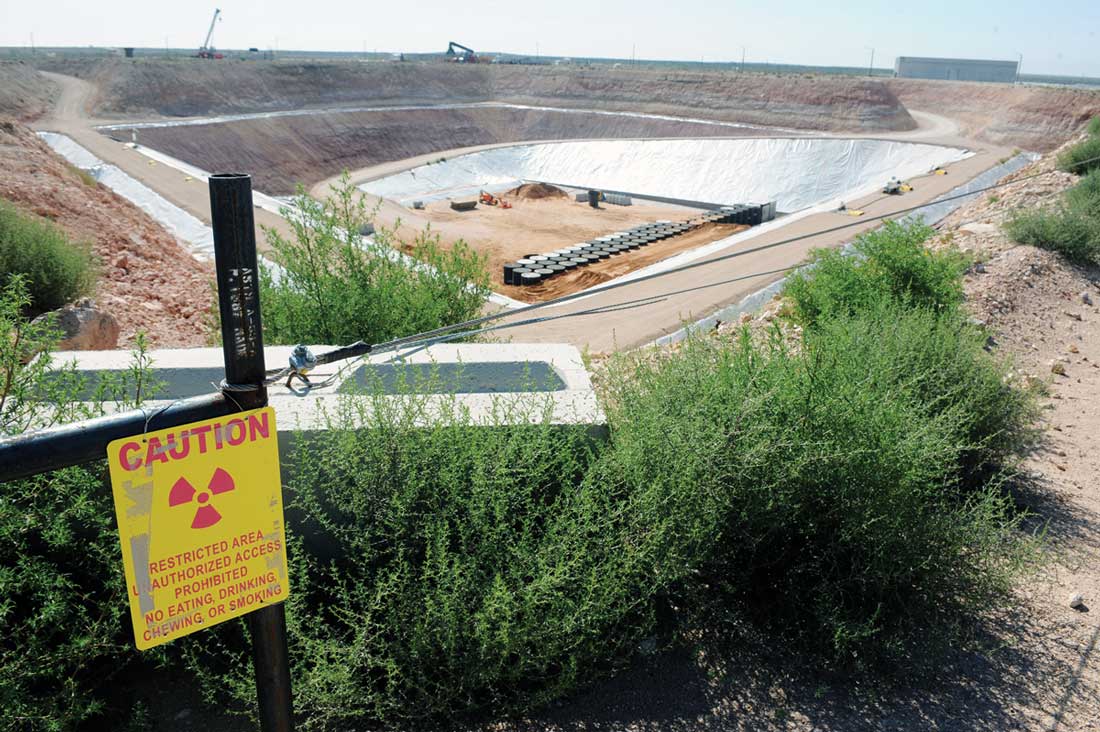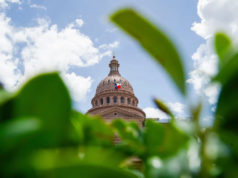A controversial storage facility in West Texas for low-level nuclear waste could become the repository for much more hazardous forms of radioactive waste in coming years if owners go forward with plans to seek new licensing.
Environmentalists, most of whom have opposed the plant operating even at its current level, say such a move would open up many parts of Texas to enormous environmental risk, including contamination of the huge and critical Ogallala Aquifer, and could provide terrorists with an opportunity to get their hands on material from which bombs could be made.
The Andrews County site has been controversial since Waste Control Specialists — the Dallas-based company owned by the late Harold Simmons, a billionaire and generous Republican donor — applied for its initial license in 2009. Three members of the Texas Commission on Environmental Quality technical team tasked with reviewing the application, along with several TCEQ geologists, quit when their recommendation that the license be denied was ignored. Their complaint was that the site sits atop a portion of the Ogallala Aquifer and that the chamber holding the radioactive waste would be only 14 feet above groundwater that leads into the aquifer. The Ogallala underlies eight states and provides water for agriculture in a huge swath of Texas and the Midwest.
“Rather than denying the license,” said Lon Burnam, who is at the end of his tenure as a Fort Worth state representative, “TCEQ changed the maps to show that the site was not actually atop the Ogallala aquifer. That didn’t change the reality of course, but it allowed the license to be granted.” Burnam has been possibly the most vociferous critic of the Waste Control site since it was proposed.
When the 1,338-acre facility opened in 2011, it was licensed to store low-level nuclear waste — some material from nuclear plants, hospital X-rays, medical research waste, and contaminated gas drilling pipe — only from Texas and Vermont.
Less than a year later, however, TCEQ permitted Waste Control to expand its operations to accept similar nuclear waste from 34 states, further enraging environmentalists concerned with thousands of truckloads of the material being shipped across the country, endangering people along the truck routes and putting additional pressure on the waste facility.
The company, now owned largely by Simmons’ family, is raising the hackles of environmentalists again because it is considering seeking new licensing — first from TCEQ and then from the Nuclear Regulatory Commission — that would allow it to store high-level waste from nuclear power plants around the country. Some spent nuclear fuel includes plutonium, the material in nuclear weapons.
“What we’re looking at is the possibility of seeking a permit for the interim storage of spent nuclear fuel,” said Waste Control Specialist spokesman Chuck McDonald. “Of course, when we are talking ‘interim’ in terms of nuclear waste, we’re talking about decades, not weeks.”
Those decades could turn into centuries — there would be no end date until a permanent storage facility is designed. Permanent storage of nuclear waste, of course, involves keeping waste containers intact and leak-free for thousands of years.
Such spent fuel is still held at the nuclear power plants where it was used. With several of those plants having been shut down in the past several years and more slated for closure in the near future, McDonald said it makes more sense to have all of that fuel in one place.
“This is the fuel that was originally meant to be stored permanently in Yucca Mountain in Nevada,” said McDonald. With that project shut down, “the spent fuel has been stranded since then, and the thinking — which comes from a blue-ribbon panel that President Obama commissioned to look into the issue — is that it would be better to get the spent waste from dozens of locations to a single location.”
The Yucca Mountain site, on federal land about 100 miles northwest of Las Vegas, next to an old atomic bomb testing grounds, was initially considered because of its geological stability and the fact that the waste could be stored 1,000 feet deep in solid rock that was also 1,000 feet above the water table. The water strata there did not feed into any aquifers, so the chances were considered small that any groundwater contamination would occur even in the event of a major catastrophe.
Though scientists agreed it was as safe a place for the spent fuel as could be found, the people of Nevada lobbied hard against it — you couldn’t get elected to statewide office if you were for it — and the project was eventually defunded in 2011.
McDonald said that the WCS location in Andrews County is the next-best place for it. “We’ve got 14,900 acres of land here, with a 1,200-foot layer of nearly impermeable red clay in which to store it.”
Glen Lewis, who quit the TCEQ technical team when the initial license was granted, said at the time that groundwater is only 14 feet below the bottom of the radioactive waste dump trenches — “not an adequate safety margin for a site that is supposed to isolate radioactive waste for tens of thousands of years. … If water intrudes into the landfill, radionuclides could escape confinement and permanently contaminate groundwater.”
McDonald said the land is geologically stable, gets little rainfall, and is not near a population center.
Burnam said the dangers and requirements of keeping high-level waste weren’t taken into consideration in giving the site its current license.
“That site was simply not permitted nor built for that type of high-level contamination containment the company is now thinking of storing there,” he said. “The site has been growing exponentially since it opened, but with the way the company lines the pockets of the people who are in a position to allow continued expansion, they’ll probably get away with it on a state level. If they wield enough influence to get maps changed, they have enough influence to get the new license.”
Karen Hadden is executive director of the Sustainable Energy and Economic Development Coalition. Like Burnam, she and the clean-air SEED Coalition have opposed the site since it was first proposed. She, too, is dead set against further expanding it.
“This is high-level nuclear waste that contains plutonium, and there is a risk of that being stolen during transport and made into weapons, so moving that spent fuel poses a significant terrorist risk,” she said.
“This waste is so hot that it shouldn’t be transported on highways or trains,” she said. “It’s incredibly dangerous. If you were exposed to it from three feet you’d get a lethal dose in minutes. A single major accident during transportation, and you have no idea how many people could be impacted, how much water could be contaminated. And then what if a terrorist group decided to hijack a truck carrying it? We’re talking about thousands of truckloads, so they’d be nearly impossible to fully protect.”
Hadden said the material should stay where it is, in thick, dry casks made of steel-reinforced concrete.
McDonald disagreed. “Protecting the material would be considerably easier if it were in a central location,” he said. “The material would arrive in dry storage casks, and those casks would never be opened. They would remain in those casks and be buried just as they arrived.”
McDonald would not speculate about the depth at which the material would be buried or what the storage facility would look like. “That would be determined by the Nuclear Regulatory Commission, not us. They’d tell us what to build, and we’d do it.”
While Waste Control is interested in taking in the dangerous material, McDonald said it is too early in the process to tell whether it will actually happen.
“We’ve begun having a series of community meetings in both Andrews and Eunice, New Mexico, to get a feel of how the nearby communities feel about it,” he said. “So far their feedback has been very positive. Once we finish that phase, we would move on to the licensing phase of the project. But we’re not there yet.”
“Of course the people there are for it,” Hadden said. “They work [at the facility]. But there is a lot of science that should be done before this goes any further. We don’t know if the Andrews site would be right for this at all. And right now there is no urgent need to move this material from where it is. It’s under guard. Moving it exposes it to accidents and terrorist theft. But for the company, it’s about making money.”
“The initial problems — when the site was taking in low-level nuclear waste — were bad,” Burnam said. “But now the company is planning on compounding those problems by bringing in high-level waste. It’s all about maximizing their profits at the expense of the people of Texas.”












